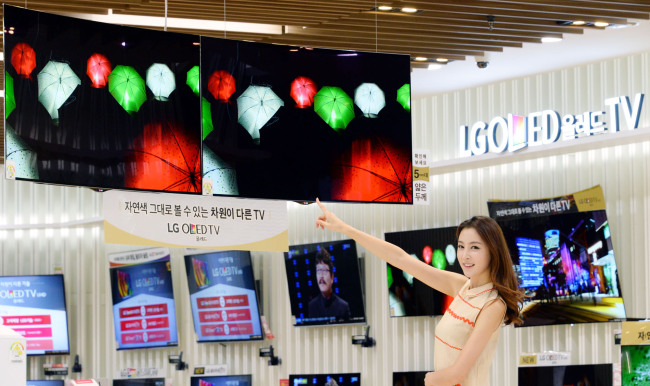LG Display said Friday it would invest a whopping 10 trillion won ($8.7 billion) in building a new plant for organic light-emitting diode displays in Paju, Gyeongi Province.
The firm’s recent investment plan is part of its initiative, which was announced in August, to invest 10 trillion won in projects to foster businesses for OLEDs along with liquid crystal displays over the next three years.
The nation’s leading display manufacturer will first pour 1.84 trillion won into the construction of a new OLED factory, dubbed the P10, which is expected to start operations in the first half of 2018.
 |
A model poses with LG Electronics’ OLED TV. (LGE) |
An official said the company will make further investments to increase production in phases at the P10 down the road.
“The latest investment decision in the P10 line will be a watershed in the global display market as it would help Korea continue to lead the industry, outrunning other competitors,” said Han Sang-beom, the chief executive of the LG Group affiliate, in a press statement.
The planned OLED plant will be built inside the company’s display complex in Paju city, located northwest of Seoul, and devoted to production of OLED displays.
Not only LG Group, but also the Korean government is giving a boost to the business decision of the Seoul-headquartered display maker.
In an executive reshuffle that took place this week, the LG Display CEO was recognized for his devotion to the new display segment as he was promoted to vice chairman of LG Group.
 |
A model poses with LG Electronics’ OLED TV. (LGE) |
LG Group currently has six vice chairmen who head respective affiliates or business units, including Koo Bon-joon, the chief of the conglomerate’s unit for new growth businesses, and Park Jin-soo, the chief of LG Chem.
The Ministry of Trade, Industry and Energy will also set up a task force to give momentum to LG Display’s grandiose investment plan.
The government task force consisting of officials from the transportation ministry, the environment ministry and local governments will make efforts to beef up infrastructure, including roads, power and water supply facilities and water treatment plants, in and around the Paju complex.
The P10 facility will be built on land measuring 382 meters by 256 meters -- equivalent to 14 soccer fields -- and the building will be more than 100 meters tall.
LG Display said that it would produce a wide variety of OLED displays, including those for smartphones, phablets and TVs.
Over the past several years, LG Display has been making a series of investments in OLED, which is widely considered the future of the display business.
The OLED displays have competitive edge over the traditional LCD panels with their faster response speed and better contrast and color expression.
The OLED display built on plastic substrates rather than glass can be utilized in various products, including rollable and foldable devices, thanks to its flexible nature.
Some market watchers suspect that the newest plan to build the OLED plant is in line with the anticipated supply of OLED displays for Apple’s iPhone 8 handset.
“Apple is in discussions with OLED display makers -- LG Display and Samsung Display to equip the flexible display in the next iPhones,” said an industry source, refusing to give details on the talks.
“The adoption of OLED in the next iPhones will likely deal a huge blow to Japan Display, one of the current LCD suppliers for Apple handsets.”
Display industry researcher IHS anticipated in a report that the global OLED market would more than double to $29 billion by 2022 from $13 billion in 2015.
By Kim Young-won (
wone0102@heraldcorp.com)









